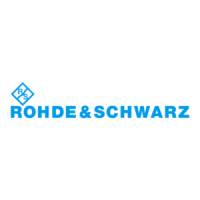Concepts and features
R&S
®
ZNA
249User Manual 1178.6462.02 ─ 20
ters. A different behavior is expected for nonlinear balanced devices, where the trans-
mission characteristics of the DUT may depend on how closely the stimulus signal
matches real operating conditions.
In true differential mode, a R&S ZNA with two or more internal sources generates true
differential and common mode stimuli at arbitrary reference planes in the test setup
and determines mixed-mode S-parameters, wave quantities and ratios. It can also per-
form true differential measurements on frequency-converting DUTs or to use true differ-
ential mode in combination with external frequency converters. Moreover the true dif-
ferential mode provides two additional sweep types, the Amplitude Imbalance and
Phase Imbalance Sweep.
●
Like the virtual differential mode, the true differential mode requires a port configu-
ration with at least one balanced port. However, in true differential mode a bal-
anced source port requires independent sources for the constituent physical ports.
– On a 2-port R&S ZNA, the optional internal second source is required.
See Chapter 4.7.22, "Internal 2nd source and 2nd LO generator for 2-port
R&S ZNA", on page 274.
– To have two balanced ports, a 4-port R&S ZNA with 4 sources is required.
See Chapter 4.7.19, "Internal 3rd and 4th source for 4-port R&S ZNA",
on page 273.
●
Because true differential mode is a special kind of Phase coherent source control,
option R&S ZNA-K6 is a prerequisite for option R&S ZNA-K61. The Prerequisites
for accurate phase control also apply to true differential mode
4.7.5.1 Virtual vs. true differential mode
The analyzer uses different stimulus signals and different mathematical methods to
obtain results in normal, virtual differential, or true differential mode. The following table
gives an overview.
Normal (unbalanced)
mode
Measurement of wave quantities and S-parameters for unbalanced ports. Unbal-
anced stimulus signals.
Virtual differential
mode
Precondition: At least one balanced port is defined.
Measurement of unbalanced wave quantities using unbalanced stimulus signals.
Unbalanced system error correction. Conversion of unbalanced wave quantities
into balanced and mixed-mode S-parameters with possible renormalization of port
impedances.
True Differential
Mode
Precondition: At least one balanced port is defined, whose constituent ports are
driven by two independent sources.
Measurement of unbalanced wave quantities using balanced stimulus signals (dif-
ferential and common mode). System error correction and conversion of unbal-
anced into balanced wave quantities. Calculation of balanced and mixed-mode S-
parameters with possible renormalization of port impedances.
True differential mode relies on wave correction. A consistent system error correction is
essential for accurate balanced waves at the reference planes and accurate measure-
ment results. Perform a full n-port calibration (TOSM, UOSM or one of the Txx calibra-
tion types) of all physical ports involved in the true differential measurement and
Optional extensions and accessories

